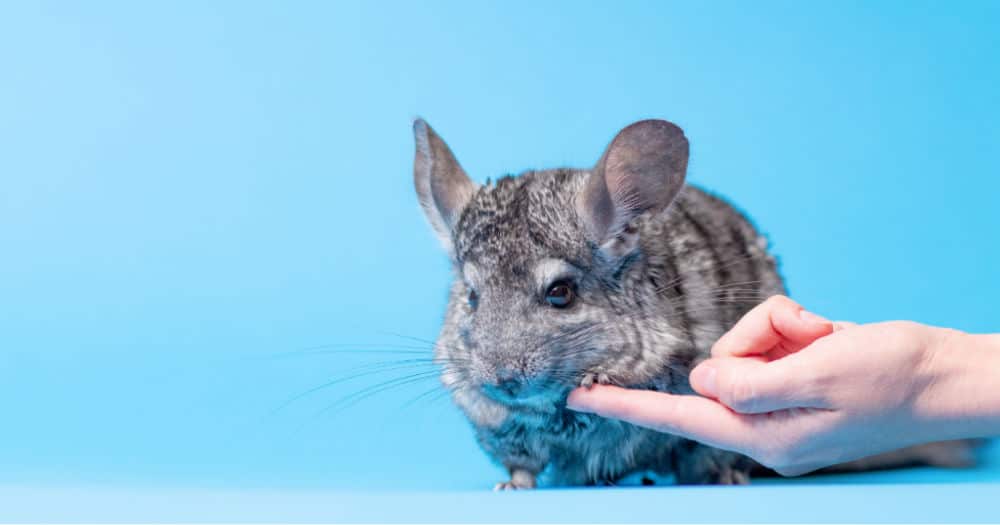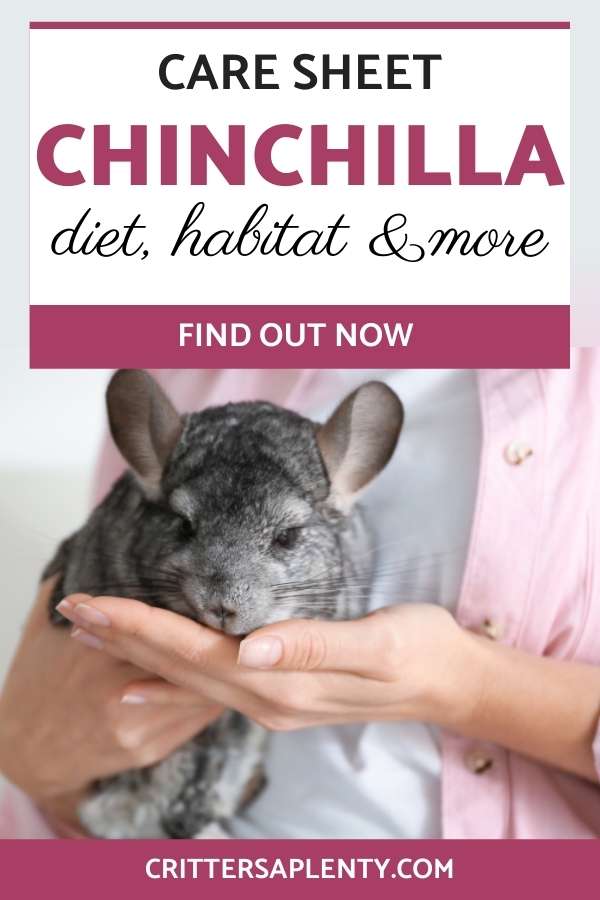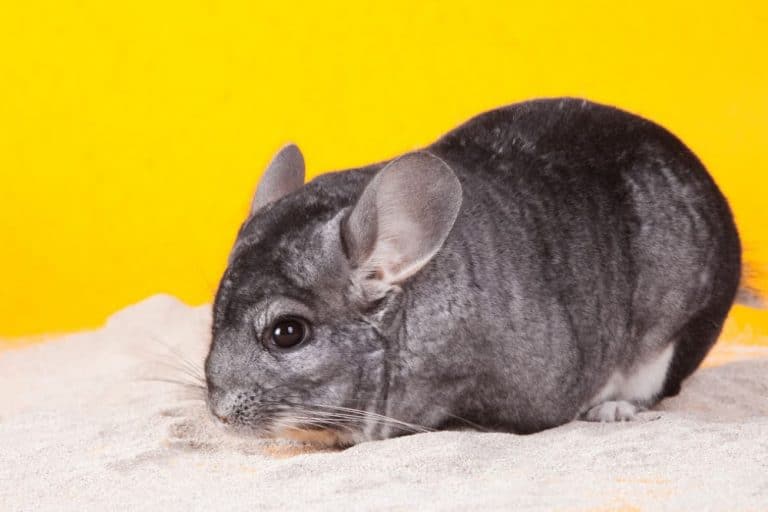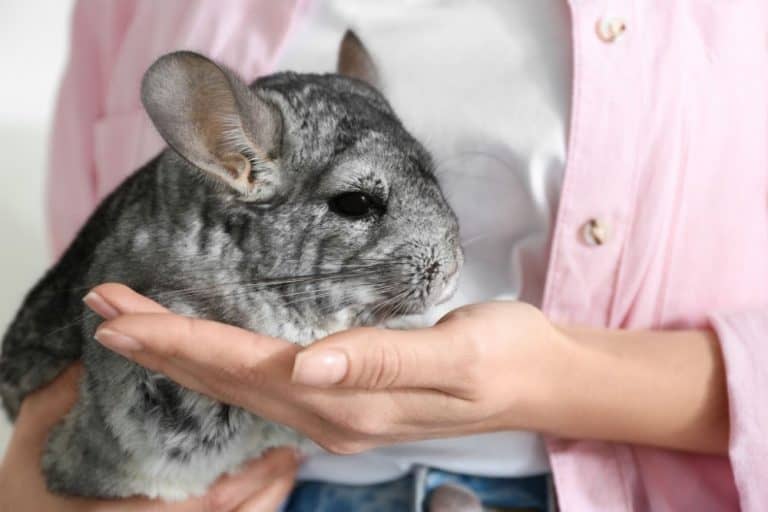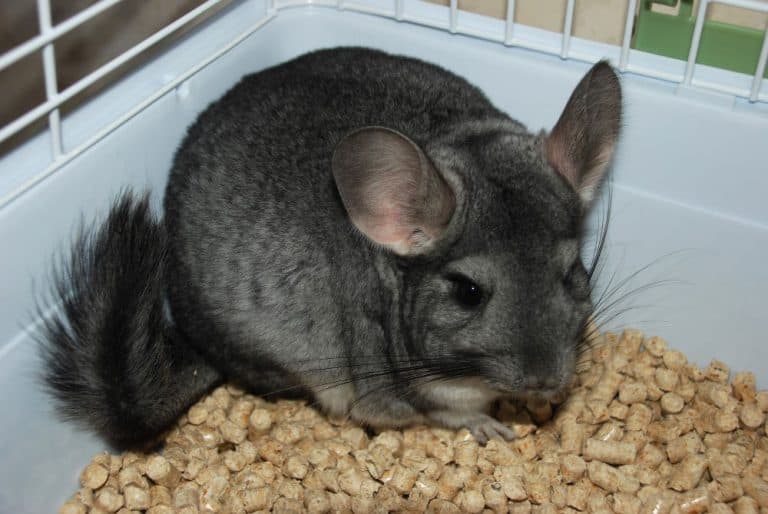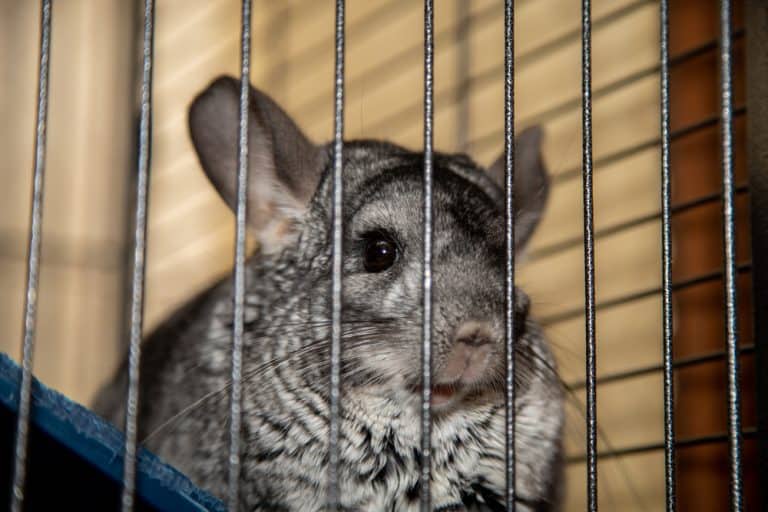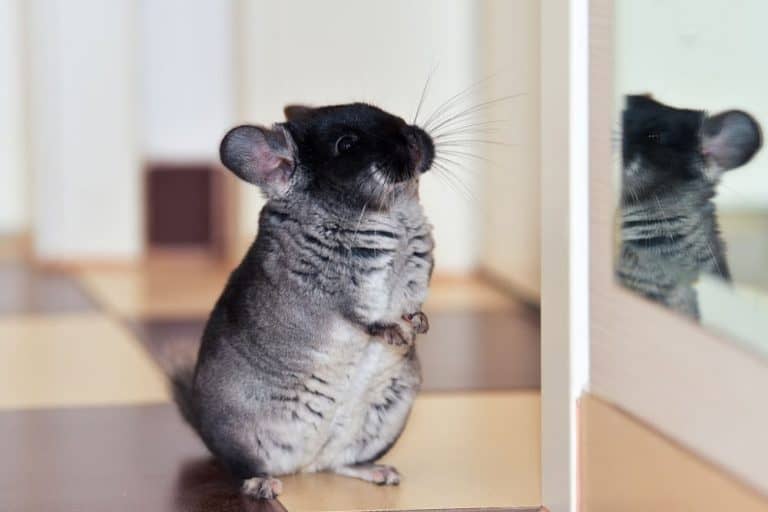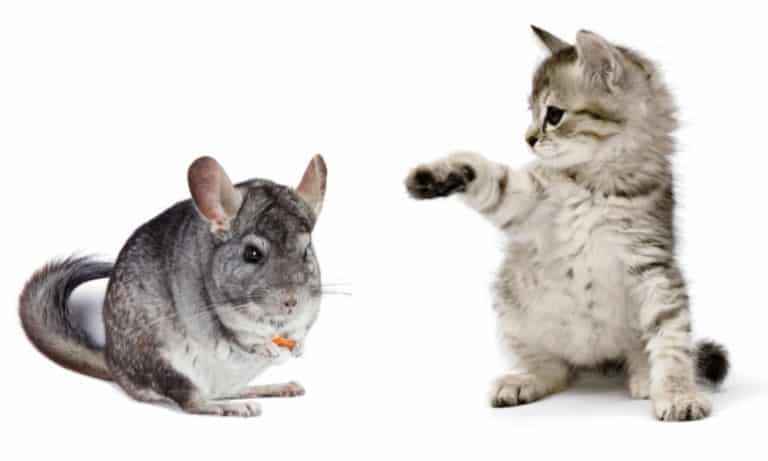Chinchilla Care Sheet: Diet, Habitat, & More
The remarkable chinchilla has won the heart of millions of proud pet parents all over the world. No one can resist their curious noses and enchanting eyes. Not to mention they are the softest creature ever to walk this earth. If you are reading this chinchilla care sheet, you are probably getting ready to bring one home yourself. We have taken the time to give you as much information as possible in one article. A safe place that you can go to as a reference on all things chinchilla.
Chinchilla Overview
The chinchilla originated in Northern Chile at the top of the arid Andes Mountains. These small creatures were prized for their meat and coats by the native Incans. And when the Americas became colonized, fur traders took note of their precious fur. And in the 1920s, the domestication began for the fur trade, and eventually as pets.
As you can see, these pets have not been domesticated long at all. There has been a great deal of research put into caring for these delicate pets. And with the help of science, the average chinchilla can now live 15-20 years. While it may seem like a lot to take care of chinchillas, you get the hang of it pretty quickly and shouldn’t have any troubles.
Housing And Enrichment For Chinchillas
First on our list of chinchilla care is where to house them. Chinchillas are quick to escape and impressive chewers. They do best when their cage is at least 2ft w x 2ft d x 3ft h. But if you have multiple chinchillas, you will want to have an additional 2 square feet of space per chinchilla added. Chinchillas are a herd animal and usually have large families. Your chinchilla will do best with at least one friend. But some chinchillas are okay alone. If you decide to have a friend for your pet, be extra cautious to keep them in same-gender pairs. The breeding process can be challenging and demanding for a mother.
The best chinchilla cages will be made of chew-proof metal. These guys are amazing chewers. If you have a plastic bottom and nothing to keep them in, they will chew through it within a night. Another thing to look out for is how far apart the bar spacing is. Chinchillas might look like fat puffballs, but trust us, it’s all hair. Their bodies are actually very slim, and anything larger than 1-inch wide is an escape waiting to happen.
And to make their cage a home, you need to give them lots of enrichment. Chinchillas love toys, wheels, chew sticks, hideouts, and lots of shelves. Giving your chinchilla enough space to run, jump, and play will let them thrive. But before you go out looking for all of these, you need to know what is safe for them. Chinchillas have a sensitive digestive system, and many things are toxic.
All toys and chew sticks should be made of wood and no plastic. But not all wood is equal for chinchillas. Wherever you get these branches, they need to be free of pesticides and dried. Some favorites are apple, grapevine, elm, berry branches, bamboo, hazelnut, willow, pear, aspen, and pine. Most other woods are considered toxic to your chinchilla. It is best to buy most of your chinchilla toys online from stores that cater to a chinchilla’s specific needs. But some owners find great luck with using wood bird toys at their local shops.
Wheels should be at least 16 inches in diameter and made of wood or metal. And hideouts should also be made of wood. Plastic is hazardous to chinchillas because if they eat it, it can cause intestinal blockages. Even if your chinchilla doesn’t chew on them at first, it is only a matter of time before they are destroying everything.
And finally, your chinchillas should have multiple levels. Since chinchillas originate in the mountains, they love to climb and jump. Some chins can even jump as high as 6 feet. Giving them multiple levels lets them have room to jump and stretch as they need to. It also gives them more room to use as a play place. All of these are important in chinchilla care because, without enrichment, they become bored, and their health will deteriorate with it.
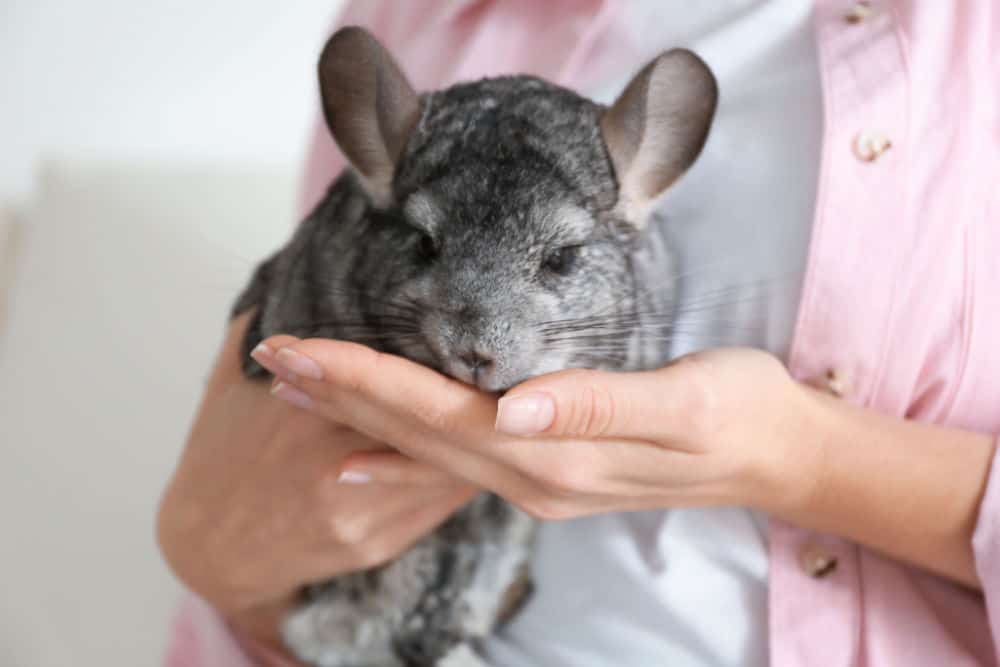
The Perfect Chinchilla Climate
The placement of your cage is as important as what cage you get. Since these cages can be large and take up a lot of room, you need to make sure that the placing is just right. The optimal temperature for chinchillas is anywhere between 60-72 degrees Fahrenheit. As long as their water isn’t frozen, there is no such thing as too cold for them. Up in the mountains where they come, the air is cold and dry. Chinchillas have adapted their lush fur to keep them warm.
In fact, their hair is so thick because they have up to 60 hairs per follicle. Compared to the measly 2-3 that humans have, that is a lot. The downside to this is that they overheat quickly. Anything over 75 degrees can give a chinchilla a heat stroke. So wherever you place your cage, be sure that it has A/C and out of direct sunlight. But be cautious that it isn’t too drafty or your chinchillas could get sick. Most chinchilla owners place window units inside the room where their chinchillas live so that they can regulate the temperature of that room independently of the entire house.
Bedding And Litter Training For Chinchillas
Now that you know where to put the perfect cage, let’s talk about bedding. Most cages made for chinchillas have removable plastic shelves. These shelves aren’t the best for real bedding, so most people use fleece. You can make your own “pillowcase” style liners using no-pill fleece. Fleece is reasonably cheap, and you can find it in any fabric store. And if you aren’t crafty, you can buy them online. We recommend making at least two pairs so that you can wash one while using the other.
If you replace the plastic pans with metal pans with high sides, you can use bedding if you prefer. The best loose bedding is either aspen or pine wood shavings. Both of these are incredibly absorbent and reduce odors. Wood shavings are also very cheap to buy, and you can buy them in bulk at any feed store.
You might notice that most pet stores use paper bedding, but we never recommend these. We already mentioned that chinchillas have sensitive digestive systems, and they chew everything. Pair that with eating paper bedding that will expand in the stomach, and you have problems waiting to happen. Many chinchillas die every year to impaction caused by this bedding. It is best to use safe bedding that won’t hurt them if they ingest it. Both aspen and pine are safe for consumption, and no-pill fleece won’t block their digestive tracts or get caught on their paws.
If you want to make clean up even easier, you can also litter train your chinchillas. Many people buy glass pyrex cookware or metal pans for litter boxes that are chew proof. And you can use whatever bedding that you already have inside the litter pan too. Aspen, pine, or small cuts of fleece can all make for great litters.
Litter training is simple for chinchillas. Once you have your chew-proof pan and litter, all you need to do is find their favorite spot. All chinchillas will find a corner or two that they prefer to urinate in. Put your pan in those corners with a few droppings of poop, and they will gladly use it. Sometimes they find their ways into other corners, and that’s okay. Just move the litter box until they seem to understand that the box is where they need to go. Unfortunately, though, you can’t train them to poop there.
What To Feed Chinchillas
Next up on our chinchilla care sheet is what to feed your chins. Chinchillas are herbivores with a delicate system. Your chinchilla’s main diet will be timothy hay. They should always have timothy hay available, and they do eat a lot of it. This hay has enough fiber and roughage to keep their stomachs and teeth happy. But you also need to supplement with a pelleted diet.
Not all chinchilla pellets are the same quality. You want to find a chinchilla food that doesn’t have any nuts, fruits, seeds, or treats mixed into it. These “foraging” mixes do more harm than good with chinchillas. Most chinchillas will pick through the pellets to find the goodies and refuse all of the healthy parts. Think of it as giving a toddler dessert along with a healthy meal. Of course, they are going to fill up on the dessert first. Foraging mixes cause pickiness and obesity and sometimes even diabetes in chinchillas.
If you want to give your chin a treat, you need to be careful with these. Where they come from, the air is dry, and there is not much vegetation. All of the food sources that they have available are dry and high in fiber, so it has made their stomachs unable to digest fruits and vegetables. Produce is too high in sugar and moisture, which in turn causes bloat and diarrhea in chins.
So what can you give as a treat? Plain Cheerios or Shredded Wheat is a favorite with all chinchillas. They love the feel and texture of the cereal against their teeth. And you will not have to worry at all about bloat or harmful side effects. You can also buy dried goji berries or rose hips to give to your chinchillas on occasion. And dried flowers such as dandelion, hibiscus, and chamomile make the perfect summer snack. You could also give your chins bee pollen as a treat. (Some breeders offer a homemade supplement mixture as a treat). Or there is a simpler treat of a different type of hay, like orchard, alfalfa, botanical, or meadow mixed with the timothy hay. As long as treats only make up 10% or less of their diet, any of these options are safe.
And if you are wondering about what water is safe for chinchillas, that depends on where you live. Most tap water is adequate to give your chinchillas if it is safe for you to drink. Most people prefer to give their chinchillas filtered water, but that is entirely up to you. If the water where you live is appropriately filtered and there is no fear of bacteria, then it’s safe for your chinchillas as well.
But no matter what water you give your chinchilla, having the right water bottle is vital. Chinchillas should not get wet and so you can’t provide them with a dish of water. Instead, you will want to invest in a no-drip water bottle that hangs on the outside of the cage. Glass water bottles are more sanitary and chew-proof and therefore preferred by most owners.
Chinchilla Exercise
Chinchillas spend most of their time within the den, or in this case, the cage. Their instincts are usually to only venture out for food and water in the early morning hours and early evening. Keeping toys and a wheel inside your cage is enough to keep them entertained and fit. Your chinchilla will love running on their wheels throughout the night as well. So don’t put them in a bedroom if you intend to get any sleep at night. But if you want to give them a little time outside the cage, there are some safe ways to do it.
Some owners prefer to let their chinchillas play in the bathroom because the linoleum is easy to clean and small. Other people get playpens to give them time outside the cage. Whatever way you give your chinchilla exercise, just be sure that you chin-proof the area. Make sure that there are no holes that your chinchilla can escape through. And block off all objects and cords that you don’t want your chinchillas to chew on. Giving them 30 minutes outside of the cage in a safe environment is plenty for your chinchillas.
Common Health Issues In Chins
Though we wish chinchillas were immune to diseases, it’s not true. Chinchillas are prone to some health issues due to genetic mutations, bad breeding, or improper chinchilla care. Here are just a few of the most common health concerns most chinchillas experience at some point in their lives.
- The first is fur slip. A fur slip is when a chunk of hair is dropped due to fighting, improper handling, or high anxiety. It is a form of self-defense against predators. When a chinchilla gets scared or grabbed in the wrong way, they drop their fur. If this happens, don’t worry. It will grow back slowly but surely.
- Bumblefoot is another common health issue for chinchillas. But unlike other things, this one is due to unclean habitats. Bacteria will grow in the urine proteins in bedding if it is not cleaned enough. All it takes is a little cut on the foot or a small splinter, and that bacteria causes an infection called bumblefoot. To prevent bumblefoot, you need to clean away all splintered wood pieces daily and clean bedding at least once a week.
- Another health concern is respiratory illnesses. Keeping the cage clean and free of chemicals is one way to ensure their lung health. You also don’t want them hanging out with other small animals that are prone to respiratory disease.
- Malo (malocclusion – mal, meaning ‘bad,’ and occlude, meaning ‘to fit’ or ‘to align’, is a misalignment of the teeth) is a deadly disease due to a genetic mutation in some chinchillas. It is characterized by their teeth turning from dark orange to white, becoming brittle, or overgrowing. This disease is painful and causes other infections in the teeth and gums. Most chinchillas who get this disease don’t live a long life.
- If you have a male chinchilla, hair rings are prevalent. A hair ring is when the chinchilla’s fine hair wraps around the penis and cuts off the circulation. Most males know to clean this off themselves, but in some cases, they can’t remove it. If you have a male, you should check weekly that all hair is removed from the penis to prevent infections.
- And finally, GI stasis is very common in chinchillas. Whether it’s stress, heatstroke, poor diet, or dental infections. At some point or another, all chinchillas will lose appetite and have a hard time bouncing back from this. Most owners have to take to hand feeding critical care to boost their energy. Finding the source of the problem is the first step in resolving these issues.
How Can I Be Sure That My Chinchilla Is Healthy?
As a pet owner, we strive to catch illnesses before they come on. But since chinchillas are a type of rodent, they hide pain and diseases. Usually, by the time you start to notice that something is wrong, they have been sick for days. That is why it might seem like they deteriorate quickly. But there are a few things you should look for daily to give you a clue when they aren’t feeling well.
Normal Appetite: A standard chinchilla will eat between 1-2 tablespoons of high-quality pellets a day. And in addition to this, they should be eating plenty of hay. The first sign of a sick chinchilla is the loss of appetite. Without energy and the nutrition they need, they can’t fight off whatever they are suffering from.
Bright Eyes: Bright eyes without any drainage or crustiness is the sign of a happy and healthy chinchilla. What they say about the eyes being the gateway to the soul is true. If you notice that your chinchilla has watery eyes, hair missing around them, or the eyes crusted shut, your chinchilla is sick with something that needs vet attention.
Firm Stools: Healthy chinchilla poop is firm but not rock hard. It should be just firm enough to be squished but not wet and runny. If fresh poop is hard and small, then your chinchilla is constipated. If they are damp and soft, then your chinchilla has diarrhea. Both of these should be looked at by a vet.
And most importantly, there should be a lot of poop. If poop hasn’t taken over your house, then your chinchilla is not pooping enough. Chinchillas poop, on average, 200-300 pellets a night. We aren’t saying you need to count them all, but a lot should be there.
Urinating: Chinchillas might not get a lot of water from their diet, but they should be drinking from their water bottle frequently. A well-hydrated chinchilla will have dark-colored urine that is dark orange. Sometimes it can look a little cloudy, which is all normal. But if the urine is clear or pale-colored, it could be a sign that they are sick.
Fluffy Fur: The chinchilla’s most noticeable trait is their fur. It should look clean, dry, and not oily. Chinchillas do shed and sometimes go through periods where they shed more with the change of the seasons. But your chins should never have bald spots, dandruff, or oily fur.
Dark Teeth: Another sign to look for is that your chinchilla’s teeth are the proper color. Typical teeth colors are dark orange-red to dark yellow. If your chinchilla’s teeth are pale yellow or white, they might have a vitamin deficiency or Malo.
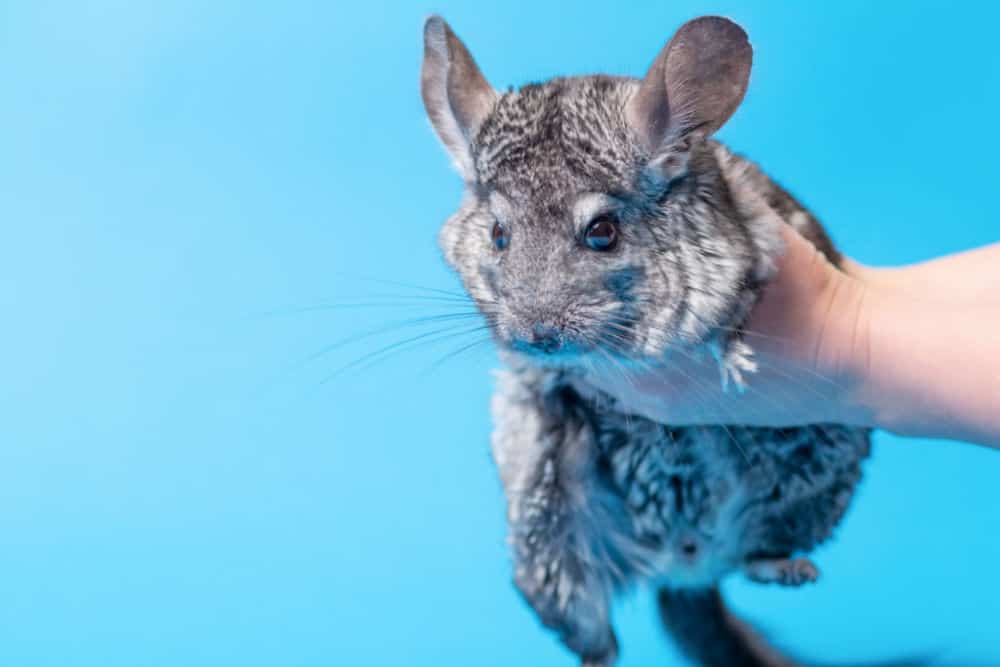
Temperament And Handling Your Chinchilla
Chinchillas are naturally curious and social little things. They enjoy companionship and lots of love. It’s not uncommon to find your chinchilla begging for attention and loving chin scratches. And chinchillas are docile enough that they are great for children who know how to respect animals.
To pick up your chinchilla can be a tricky task. It takes a lot of trust from your chins and practice from you. Once your chinchilla trusts you, it makes picking them up easier. You don’t want to chase them around the cage too much. And sometimes, bribing them with a treat makes it easier. After you gain their trust, it makes it easier to scoop them up from under the butt.
Some breeders pick up their chinchillas by the base of the tail. This method can be tricky for a new owner, but it does not hurt the chinchilla at all. Many owners prefer this method because it is quick, and there is no chance of damaging the chinchilla’s ribs.
Cleaning And Bathing Chinchillas
Next on our chinchilla care sheet is how to clean and bathe your chinchilla. Depending on what bedding you use, clean up is easy. With fleece liners, you will have to spot clean messes daily and replace the fleece once a week. To clean the fleece, remove it and wash it in the washer. Be sure not to use any strong scents or fabric softener in the wash because of your chinchilla’s sensitive nose. You might have to spot clean the shelves in your cage if they are really messy.
If you use bedding, you will spot clean daily as well and replace it weekly. To do a deep clean, you will need to dump the bedding and clean the liners. The best cleaner for this job is a 1:1 ratio of vinegar to cut through the urine. Then after drying the pans, you will need to refill it with clean bedding. You know it’s definitely time for a deep clean when you can smell the cage.
Another important chinchilla care task is to give it baths. But you don’t use soap and water like other animals. Chinchilla fur is too dense and will mold if they get wet. In the wild, chinchillas use volcanic ash and dust to rub the oil from their hair. You can’t exactly find volcanic ash in your backyard, but you can buy chinchilla dust at any pet store. You should give your chinchilla a dust bath at least once a week, sometimes more in humid weather.
Do Chinchillas Make Good Pets?
We think that for the right family, chinchillas are a fantastic pet. But they aren’t suitable for everyone. You can love the chinchilla’s sweet disposition and mischievous eyes, but not able to care for them. And that’s okay. Not every pet is a good fit for every family. But if you don’t mind a large cage and special diet restrictions, the chinchilla is a good candidate for you.
If you can care for a chinchilla for the next 15-20 years, then you should take the plunge. Having chinchillas is rewarding and satisfying since they don’t require a lot of work. It’s even hard not to collect every chinchilla that you see. Soon your chin herd will transform from one to five.
Final Verdict
Chinchillas aren’t hard to care for. They just require a few changes from what you might know from other pets. But nothing is life-changing and unreasonable. Once you meet a chinchilla and all their cuteness, it won’t be long before you get your own. And with the help of this chinchilla care sheet, you will know everything you need to know.

